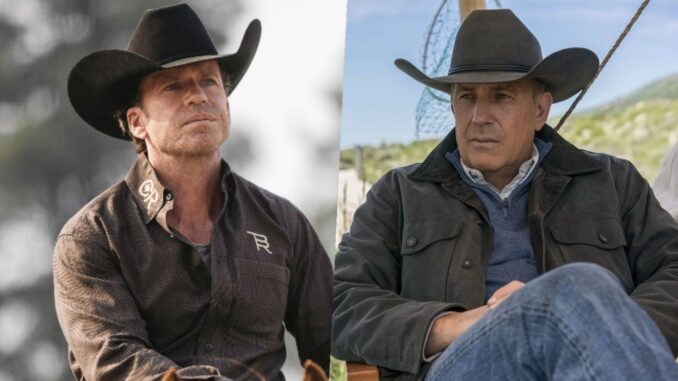
Behind the Barbed Wire: The Unseen Duel of Yellowstone's Titans
Montana’s vast, indifferent skies have witnessed countless battles for land, legacy, and power. On screen, the Dutton family saga of Yellowstone has captivated millions by dramatizing these struggles, painting an epic canvas of a modern West clinging to its soul. Off screen, however, a different, equally compelling drama unfolded, one that reflected the show’s own themes of dominance and contested territory. The escalating feud between star Kevin Costner and creator Taylor Sheridan was not merely a clash of egos or a scheduling dispute; it was an illustrative microcosm of Hollywood’s inherent tensions, a duel between an iconic screen legend and a burgeoning creative titan, fought in the high-stakes arena of a global phenomenon.
When Kevin Costner donned the Stetson of John Dutton, patriarch of the Yellowstone Ranch, it felt like destiny. He was the quintessential Western hero, a man whose filmography – from Dances with Wolves to Open Range – had cemented his place in the genre’s pantheon. For millions, Costner was John Dutton: stoic, protective, a man carved from the very land he defended. His presence lent an undeniable gravitas to Taylor Sheridan’s gritty, authentic vision. Sheridan, a former actor turned prolific writer-director, had conjured a universe that resonated deeply with America's yearning for rugged individualism and familial loyalty. He was the architect, the storyteller, the one who saw the entire, sprawling map of the Dutton empire. In the nascent seasons, this synergy was golden, a partnership that yielded critical acclaim and an audience hungry for more. Costner brought the star power and the weathered authenticity, while Sheridan provided the relentless narrative drive and the brutal poetry of the West.
Yet, the very forces that forged Yellowstone into a juggernaut also contained the seeds of its ultimate unraveling. Both Costner and Sheridan are men of immense vision and an unyielding desire for creative control. Costner, accustomed to shaping his characters and even directing his own epic Westerns, likely saw John Dutton as more than just a role; he saw a legacy, a character worthy of his full artistic investment. Sheridan, on the other hand, is known for his singular, almost autocratic, control over his narratives. He is the master craftsman, meticulously weaving every thread of his expanding cinematic universe, from Yellowstone to its prequels 1883 and 1923, and beyond. To him, the script is king, the story is sacrosanct, and the actors are conduits for his vision, not co-authors.
The practical fissures began to show as Yellowstone exploded in popularity. Costner’s commitment to his passion project, the multi-part Western film saga Horizon, became the public flashpoint. Filming Horizon demanded extensive time and resources, directly conflicting with Yellowstone's demanding production schedule. Reports surfaced of Costner wanting fewer shooting days, a more flexible schedule, and even input on John Dutton’s ultimate fate. This clashed directly with Sheridan’s production model: a fast-paced, high-volume output where character arcs are meticulously planned and tightly controlled from the writer’s room. For Sheridan, who was now overseeing an entire television empire, any deviation from his meticulously crafted schedule or narrative could ripple disastrously across multiple productions.
The true "behind the feud" narrative, then, wasn't just about dates on a calendar; it was a battle for narrative authority and creative ownership. It was the established movie star, accustomed to being the sun around which projects revolved, clashing with the ascendant showrunner, who believed he was the sun, the gravitational center of his own universe. The Montana landscape, with its sweeping vistas and untamed spirit, served as an ironic backdrop to this very human drama of ambition and control. Just as the Duttons fight to preserve their land from external threats, Costner and Sheridan each fought to preserve their artistic autonomy, their vision of the story and their place within it.
Ultimately, the illustrative nature of this feud lies in its reflection of the shifting power dynamics within Hollywood. The traditional hierarchy, where the movie star commanded the most leverage, has been significantly disrupted by the rise of prolific showrunners and the streaming era’s demand for endless, high-quality content. Taylor Sheridan, as the architect of a sprawling, successful franchise, held a unique power, perhaps even surpassing that of his lead actor. Costner, in turn, remained a legend, but one whose personal artistic aspirations conflicted with the insatiable demands of a television empire built by another.
The dust has now settled, with Kevin Costner’s departure from Yellowstone confirmed, leaving John Dutton’s fate—and the show’s conclusion—to be navigated by Sheridan alone. The feud serves as a poignant, if costly, illustration of how even the most brilliant collaborations can buckle under the weight of competing visions and unyielding wills. Like the unforgiving land it portrays, the world of Yellowstone proved large enough for only one king, and the unseen duel behind the barbed wire left its own indelible mark on the saga of the modern American West.
